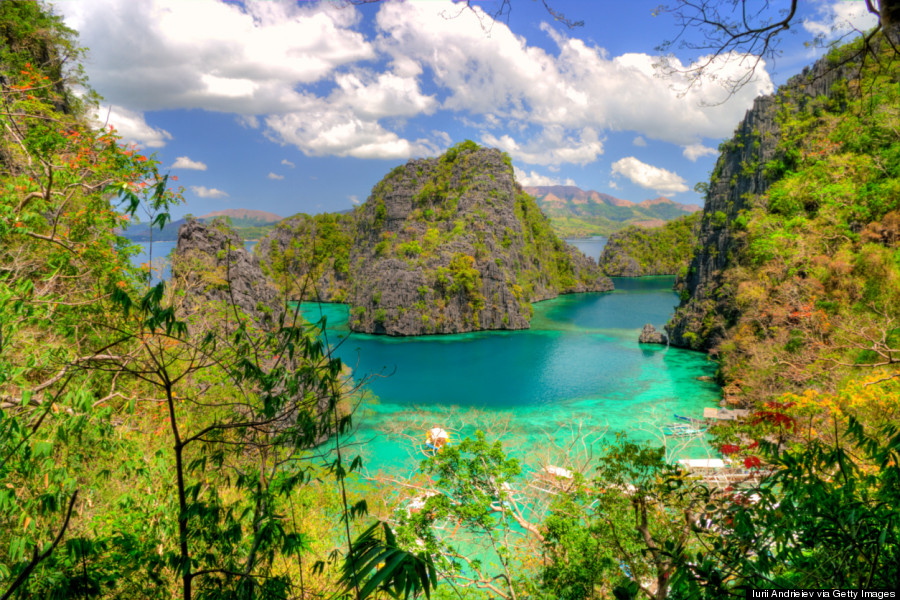Archeological evidence suggests that the Negritos, a broad term for indigenous people of dark complexions, reached the Philippines over 30,000 years ago by a land bridge from the Asian mainland following the migration of animals. Excavation at Palawan’s Tabon cave yielded a human skull carbon-dated to 22,000 B.C. About 10,000 years ago, the ice melted, the sea level rose and the land bridges disappeared.
Waves of Indonesians followed by sea from 3,000 BC, and Malays got a firm foothold around 200 BC, followed in later centuries by waves of Chinese settlers. Most of today’s Filipinos have grown out of intermarriages between indigenous and Malay people. Modern Filipino culture, including language and cuisine, was heavily influenced by the Malays, who also introduced arts, literature, and a system of government.
A few centuries before the Spanish reached the Philippines in the 16th century, Filipinos involved in trade had also met Arabs and Hindus from India, while the expanding Chinese population wielded considerable commerical power. Muslim clergy start to bring Islam to the Philippines from Indonesia and Malaya via Borneo in the late 14th century.
The Philippine population is a mix of tribal and ethnic groups representing 111 linguistic, cultural and racial groups. The majority is of Filipino-Malayan descent with Japanese, Chinese, European and American added to the mix. The minority is the aboriginal group called Negritos whose average height is about 58 inches, dark brown to almost black skin color, wide noses and tight curly hair. The Negritos or Little Negroes are one of the dwarf Australoid people of the ancient populations of the world. It is believed that inland forest situations with very few proteins and steep terrain contributed to their short stature. They kept to the deep forests while the Igorots kept to the mountains. They have survived because of their secluded location. The Negritoes survived by hunting and fishing and eventually had adopted a rudimentary form of farming. Local groups were composed of five to ten families living in a group of thatched lean-tos around a circular space. The leader of the band was determined by age or consensus. The group moved frequently for economic reasons or because of deaths, feeling of ill luck or quarrels. They have their own distinct language.
There are about 87 different languages and dialects spoken in the Philippines. Tagalog was made the national language in 1946. Tagalog was changed to Pilipino in 1962. Most of my generation still call it Tagalog. English is also widely used. Some young people nowadays used Taglish which is a mixture of both Tagalog and English in their conversation.
The Philippines is a conglomeration of various cultures due to the influence of different civilizations over the past 1500 years. Perhaps because of their over three centuries of Spanish rule, the Filipinos are passionate about life in a way that seems more Latin than Asian and because of their 48 years under the American administration, they can communicate easily in English and have been great imitators of American culture.
In spite of new influence from neighboring Asian countries, culture from the first settlers still remain. These include belief in the active powers of spirits and the importance of omens. Spirits once played an important part in the lives of all Filipinos, and many who have been converted to Christianity or the Muslim faith still retain a few of their ancient beliefs. The Igorots still worship their ancient gods, the highest of them is called Diwata. The Philippines is the only predominantly Christian nation in Asia.
The Philippines has been ruled by various Asian and western empires. From 200 to 1565 AD, part of the Philippines may have been ruled by Hindu-Malay empires, the Javanese Madjapahit empire and the Ming Dynasty of China. From 1440 to 1565, the northern Luzon was controlled by the Japanese and Borneo and Brunei controlled the south.
Until 3,000 years ago, contact with the outside world was minimal. Between 1500 BC and 1440 AD, the Philippines traded with Borneo, Indonesia, Japan, Persia, India and China who made the Philippines their base of operation. The earliest known trade with China occurred during the T’ang Dynasty (618 to 906 AD), although contacts did not become extensive until the Sung Dynasty (960 to 1279), Yuan Dynasty (1260 to 1368), and Ming Dynasty (14th to 16th centuries). Records show that the Chinese name the Philippines largest island “Liu sung” which became Luzon later on. Historian says that the name Visayas was derived from Swirijaya, the Indo-Malay Empire that ruled Sumatra from the 7th to 13th centuries.
Here is something to entertain you from young Filipinos at UCLA dancing the Philippine native dance called Tinikling.
[youtube https://www.youtube.com/watch?v=_WLfqDMwA_o]
The Tinikling is a pre-Spanish folk dance inspired by the tikling (heron) bird. The steps imitate the movement of the bird as they walk between grass stems and tree branches escaping the bamboo traps set by farmers.
The Tinikling is a pre-Spanish folk dance inspired by the tikling (heron) bird. The steps imitate the movement of the bird as they walk between grass stems and tree branches escaping the bamboo traps set by farmers.
It is the best performance I have seen so far. Watch those feet while they dance with blindfolds. Enjoy.
Until next time. The Philippine story continues.
Sources:
Philippine Guide by Jill and Rebecca Gale de Villa
Philippine Handbook by Carl Parkes
Compton’s Pictured Encyclopedia










.jpg)
.jpg)